Strategic Plan Residents Survey Results
On July 5, 2016, the Ferguson Township Board of Supervisors authorized the Township Manager to enter into a contract with Peter S. Marshall & Associates to update the 2014 Ferguson Township Strategic Plan.
The first step in this process was a short survey created by the Township staff using SurveyMonkey. The survey opened for responses on June 27 and closed on July 22. Its goal -- leading up to the strategic planning process -- was to guide the Board on the priorities that residents have identified for the Township in the coming years.
Methodology
The survey generated consisted of five multiple choice questions and one “comment” box that allowed respondents to provide additional suggestions on what they would like the Township to consider in a Strategic Plan update. Each multiple choice question included an “other” option to provide a response that was not included in the dropdown menu.
Results
Sixty-six (66) participants responded to the survey, but the Township has more than 18,000 residents in the Township, so this sample is far too small to make any inferences about the overall population, even if the sampling method and instrument were scientifically valid. However, when compared to prior participation rates on previous non-scientific surveys employed by the Township in the past, this survey had the largest response rate to date. There were some commonalities both in the available responses and the “other” comments provided. The following is a brief analysis of each item:
1. What do you envision will be the biggest challenge facing the Township in the next five years? Select all that apply. (n = 66)
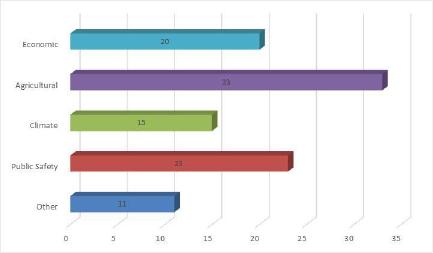
Preservation of farmland (agricultural) was viewed as the largest challenge facing the Township in the next five years by respondents, with 33 of those participating selecting this item. This was followed by maintaining a safe community (public safety) and the creation of new economic development and employment opportunity (economic). A comparatively small number of respondents (n = 15) viewed pollution, climate change, and extreme weather events (climate) as an immediate challenge.
The commonalities observed in the “other” comments included land use and development issues. Comments such as, “too many developments,” and “urban sprawl” appeared in four of the responses.
Additionally, affordable housing and preserving and protecting the Township’s water supply each appeared twice in the comments section.
Given that the overwhelming majority of participants selected preservation of farmland in their response to this item, and additional comments further reinforced the desire to limit development and urban sprawl, it can be reasonably inferred that respondents to this issue were most concerned about development and land use in the near future.
2. How do you believe the Township should invest your tax dollars in conservation and sustainability? Select all that apply. (n = 66)
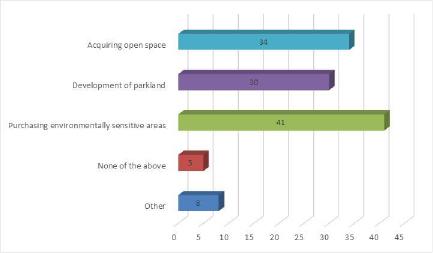
Responses to this item slightly favored purchasing environmentally sensitive areas such as groundwater recharge areas, developing riparian buffers and implementing measures to protect them (n =41). However, there was nearly equal interest in the Township acquiring open space and preserving it from development; and developing parkland for active and passive recreational use. Very few (n = 5) responded that they did not agree with any of the options offered.
Somewhat surprisingly, there were not identifiable trends in the “other” responses (see Appendix for full response list). One respondent indicated the Township should use zoning for conservation, rather than purchase certain areas. Another suggested that the township involves stakeholders to identify “key sustainability indicators” before moving forward with initiatives. Other responses suggested community farming, acquiring sensitive areas for passive recreation only, and approaching this issue regionally rather than locally.
Consistent with the 2011 Community Survey, responses to this survey indicated support for the Township to acquire open space and sensitive areas for the purposes of recreation, conservation, and sustainability. Opinions differed slightly in the approach they favored the Township take to acquire this space.
3. What services does the Township provide that you would like to see us improve upon? Select all that apply. (n = 62)
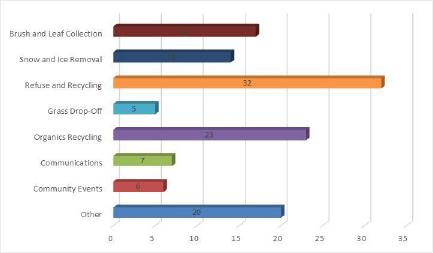
Participants responded that refuse and recycling collection, including organics recycling, were the top services they would like to see improved upon in the Township. After that, brush and leaf collection (n= 17) and snow and ice removal (n = 14) were the top responses.
This item included the largest number of “other” responses on the survey (n = 20), and several patterns were identified among them. Several of the comments indicated that respondents were “pleased with the services offered.” Another trend observed was related to code enforcement. While one respondent indicated that code restrictions were “unreasonable,” others suggested that the Township ought to do more to enforce code violations, citing homes in Park Forest and Park Hills as not being well maintained.
Finally, an overwhelming number of responses expanded on the desire to improve refuse and recycling collection services in the township. Several respondents would like to see the expansion of recycling collection to include all plastics, or for the Township to offer a plastic recycling drop-off site.
There were also several responses indicating that the Township should collect compostable garbage and yard waste, or provide funding or tax credits for home composting.
4. What do you like most about living in Ferguson Township? Choose all that apply. (n = 66)
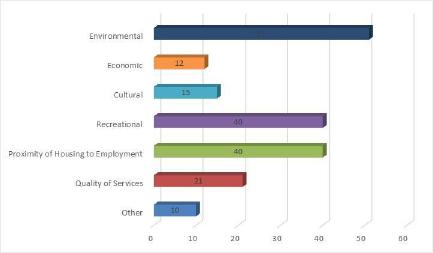
Not surprisingly, more than 50 respondents indicated that they like the environmental qualities most about living in the Township (aesthetic beauty, clean air and water, local agriculture). This is consistent with themes from the 2011 Community Survey, and other feedback from the community that has been obtained through a variety of media and engagement events. Recreation (n = 40) and proximity of housing to places of employment (n = 40) tied for second on this item.
Economic (n = 12) and cultural (n = 15) qualities received the lowest scores on this item. Respondents to this survey did not indicate that the availability of well-paying jobs and variety of opportunities were among reasons they liked to live in the Township. Similarly, respondents did not rank special events, community spirit, and friendly people (cultural) highly on their list of qualities they like about the Township. This may be indicative of areas to improve upon so as to make these qualities more attractive to residents living in the Township.
“Other” trends that were identified on this item include safety and open space, or not being overly developed. Additional responses included “affordable housing,” “schools,” and that “Township officials are approachable and friendly.”
5. How do you think the Township should promote economic development? Select all that apply. (n = 62)
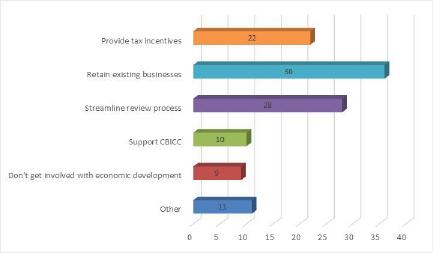
Focus on retaining existing businesses (n = 36) and streamlining the development review process for entrepreneurs and small businesses looking to grow (n = 28) were selected most frequently on this item. Additionally, 22 respondents indicated the Township should consider providing tax incentives to businesses located within the Township to promote economic development. Comparatively, there was relatively little interest in supporting, financially or otherwise, the Chamber of Business and Industry – Centre County (n = 10) or for the Township divorcing itself from economic development, entirely (n = 9).
Trends in the “other” comments relative to this item centered mostly around reducing restrictions and regulations on businesses, making it “easier for businesses to comply with zoning,” and supporting new businesses by providing assistance in finding grants, loans, advisory counsel, and other resources.
Other respondents suggested that the Township should “maintain affordable housing,” and “focus on retaining existing revenue and increase opportunities for innovative small businesses.”
It is apparent from responses to this item that participants in the study are supportive of Township efforts to retain existing businesses as part of its overall economic development strategy. Furthermore, an overwhelming trend observed in responses to this item include a desire for township officials to reduce restrictions placed on businesses through prohibitive zoning and land development requirements that make it difficult for businesses to grow and succeed.
6. Please use the space below to provide any additional feedback you would like the Township to consider in its Strategic Plan update. (n = 23)
There were many responses to this item, but not many trends that were observable within them. One recurring theme that appeared in several responses related to development. Specifically, that respondents to the survey were interested in the preservation of agricultural land and open space, and restricting further development. Again, this is a common attitude from many of the responses to Township surveys and other avenues to solicit resident feedback.
Other comments appearing under this item include making the Terraced Streetscape District more attractive to development, revitalizing Pine Grove Mills, and installing more street lighting in residential districts. A complete list of the comments can be found in Appendix A.
Conclusion
The results of the survey were very positive. Several respondents indicated that they are pleased with the direction the Township is heading, the approachability of Township officials and staff, and overall satisfaction with the services provided. Consistent with other community feedback received from the 2011 Community Survey and other community engagement initiatives, respondents valued the rural character of the Township, and supported efforts of the Board to preserve and maintain its agricultural heritage.
Other recurring themes from the survey include a desire to limit development and sprawl expand refuse and recycling collection to include organics, all plastics, and compost; preserving the Township’s water supply; and removing regulatory barriers to economic development by streamlining the review process and amending the zoning and land development ordinances.
It is worth noting again that the methodology and survey design employed in this instrument are not conducive to drawing scientifically valid conclusions that can be generalized within any confidence interval to an entire population. The Board is encouraged to absorb this feedback as part of its overall strategy of public engagement relative to the Strategic Plan update. As part of that strategy, this survey does provide some useful insight into the values the community holds in high regard. Incorporating this feedback into the conducting of the focus groups and other worksessions is encouraged to aid the Board in determining the goals, objectives, and action steps that most nearly align with the priorities of the
Township’s residents.

